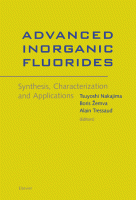Browse content
Table of contents
Actions for selected chapters
- Full text access
- Book chapterNo access
Chapter 1 - Introductory Remarks
Neil Bartlett
Pages 1-4 - Book chapterNo access
Chapter 2 - Recent Developments in the Synthesis of Inorganic Fluorides
Karel Lutar, Horst Borrmann and Marc Leblanc
Pages 5-49 - Book chapterNo access
Chapter 3 - Low Valent Transition Metal Fluorides
Howard C.S. Clark and John H. Holloway
Pages 51-78 - Book chapterNo access
Chapter 4 - High Oxidation State Transition Metal Fluorides
Boris Žemva
Pages 79-115 - Book chapterNo access
Chapter 5 - Syntheses and Structures of the Oxide Fluorides of the Main-Group and Transition Metal Elements
Michael Gerken, Hélène P.A. Mercier and Gary J. Schrobilgen
Pages 117-174 - Book chapterNo access
Chapter 6 - Oxide Fluorides of Rare Earth Elements
Masayuki Takashima
Pages 175-207 - Book chapterNo access
Chapter 7 - Oxyfluorinated Open Frameworks
Gérard Férey, Thierry Loiseau and Didier Riou
Pages 209-234 - Book chapterNo access
Chapter 8 - Optical Properties and Applications of Fluoride Glasses
Jean-Luc Adam
Pages 235-281 - Book chapterNo access
Chapter 9 - Magnetic Properties of Usovite and Jarlite Derivative Compounds
Jacques Darriet, Antoine Le Lirzin and Georges Roland
Pages 283-314 - Book chapterNo access
Chapter 10 - Luminescent Properties of Fluorides
Claude Fouassier
Pages 315-328 - Book chapterNo access
Chapter 11 - Superacidic Reaction Media
Thomas A. O’Donnell
Pages 329-366 - Book chapterNo access
Chapter 12 - Fluoride Catalysts: Their Application to Heterogeneous Catalytic Fluorination and Related Processes
Erhard Kemnitz and John M. Winfield
Pages 367-401 - Book chapterNo access
Chapter 13 - Chemistry in Perfluorinated Organic Solvents
Eric G. Hope and Alison M. Stuart
Pages 403-436 - Book chapterNo access
Chapter 14 - Surface Modification of Inorganic Materials by Fluorination Treatments
Christophe Cardinaud and Alain Tressaud
Pages 437-492 - Book chapterNo access
Chapter 15 - Fluorinated Carbon Materials for Energy Conversion
Tsuyoshi Nakajima
Pages 493-520 - Book chapterNo access
Chapter 16 - Fluorine Compounds in Battery Applications
Kiyoshi Kanamura
Pages 521-554 - Book chapterNo access
Chapter 17 - Fluorinated Fullerenes
Hidekazu Touhara and Fujio Okino
Pages 555-590 - Book chapterNo access
Chapter 18 - Fluorinated Pitch
Hiroyuki Fujimoto and Toshiyuki Maeda
Pages 591-623 - Book chapterNo access
Chapter 19 - Applications of Fluorides to Semiconductor Industries
Fuyuhiko Ishii and Yasushi Kita
Pages 625-660 - Book chapterNo access
Chapter 20 - Industrial Applications of Inorganic Fluorides
Dayaldas T. Meshri
Pages 661-682 - Book chapterNo access
Index
Pages 683-701
About the book
Description
This book summarizes recent progresses in inorganic fluorine chemistry. Highlights include new aspects of inorganic fluorine chemistry, such as new synthetic methods, structures of new fluorides and oxide fluorides, their physical and chemical properties, fluoride catalysts, surface modifications of inorganic materials by fluorination process, new energy conversion materials and industrial applications.
Fluorine has quite unique properties (highest electronegativity; very small polarizability). In fact, fluorine is so reactive that it forms fluorides with all elements except with the lightest noble gases helium, neon and argon. Originally, due to its high reactivity, fluoride chemistry faced many technical difficulties and remained undeveloped for many years. Now, however, a large number of fluorine-containing materials are currently produced for practical uses on an industrial scale and their applications are rapidly extending to many fields.
Syntheses and structure analyses of thermodynamically unstable high-oxidation-state fluorides have greatly contributed to inorganic chemistry in this decade. Fluoride catalysts and surface modifications using fluorine are developing a new field of fluorine chemistry and will enable new syntheses of various compounds. The research on inorganic fluorides is now contributing to many chemical energy conversion processes such as lithium batteries. Furthermore, new theoretical approaches to determining the electronic structures of fluorine compounds are also progressing. On the industrial front, the use of inorganic fluorine compounds is constantly increasing, for example, in semi-conductor industry.
"Advanced Inorganic Fluorides: Synthesis, Characterization and Applications" focuses on these new features in inorganic fluorine chemistry and its industrial applications. The authors are outstanding experts in their fields, and the contents of the book should prove to be of valuable assistance to all chemists, graduates, students and researchers in the field of fluorine chemistry.
This book summarizes recent progresses in inorganic fluorine chemistry. Highlights include new aspects of inorganic fluorine chemistry, such as new synthetic methods, structures of new fluorides and oxide fluorides, their physical and chemical properties, fluoride catalysts, surface modifications of inorganic materials by fluorination process, new energy conversion materials and industrial applications.
Fluorine has quite unique properties (highest electronegativity; very small polarizability). In fact, fluorine is so reactive that it forms fluorides with all elements except with the lightest noble gases helium, neon and argon. Originally, due to its high reactivity, fluoride chemistry faced many technical difficulties and remained undeveloped for many years. Now, however, a large number of fluorine-containing materials are currently produced for practical uses on an industrial scale and their applications are rapidly extending to many fields.
Syntheses and structure analyses of thermodynamically unstable high-oxidation-state fluorides have greatly contributed to inorganic chemistry in this decade. Fluoride catalysts and surface modifications using fluorine are developing a new field of fluorine chemistry and will enable new syntheses of various compounds. The research on inorganic fluorides is now contributing to many chemical energy conversion processes such as lithium batteries. Furthermore, new theoretical approaches to determining the electronic structures of fluorine compounds are also progressing. On the industrial front, the use of inorganic fluorine compounds is constantly increasing, for example, in semi-conductor industry.
"Advanced Inorganic Fluorides: Synthesis, Characterization and Applications" focuses on these new features in inorganic fluorine chemistry and its industrial applications. The authors are outstanding experts in their fields, and the contents of the book should prove to be of valuable assistance to all chemists, graduates, students and researchers in the field of fluorine chemistry.
Details
ISBN
978-0-444-72002-3
Language
English
Published
2000
Copyright
Copyright © 2000 Elsevier B.V. All rights reserved
Imprint
Elsevier Science
